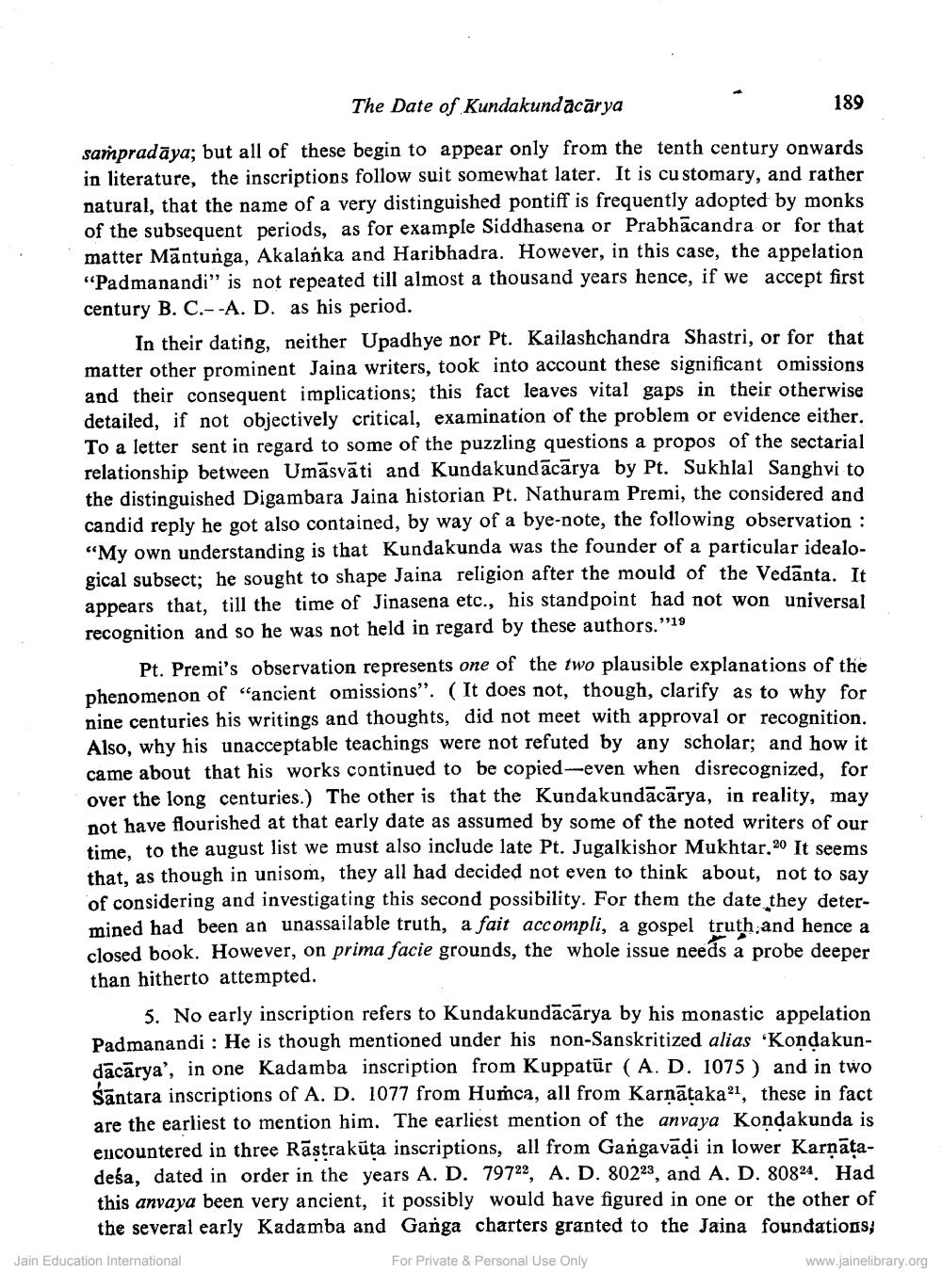Book Title: Date of Kundakundacharya Author(s): M A Dhaky Publisher: Z_Aspect_of_Jainology_Part_3_Pundit_Dalsukh_Malvaniya_012017.pdf View full book textPage 3
________________ The Date of Kundakundacārya 189 sampradāya; but all of these begin to appear only from the tenth century onwards in literature, the inscriptions follow suit somewhat later. It is customary, and rather natural, that the name of a very distinguished pontiff is frequently adopted by monks of the subsequent periods, as for example Siddhasena or Prabhācandra or for that matter Māntunga, Akalanka and Haribhadra. However, in this case, the appelation "Padmanandi" is not repeated till almost a thousand years hence, if we accept first century B. C.--A. D. as his period. In their dating, neither Upadhye nor Pt. Kailashchandra Shastri, or for that matter other prominent Jaina writers, took into account these significant omissions and their consequent implications; this fact leaves vital gaps in their otherwise detailed, if not objectively critical, examination of the problem or evidence either. To a letter sent in regard to some of the puzzling questions a propos of the sectarial relationship between Umāsvāti and Kundakundācārya by Pt. Sukhlal Sanghvi to the distinguished Digambara Jaina historian Pt. Nathuram Premi, the considered and candid reply he got also contained, by way of a bye-note, the following observation : “My own understanding is that Kundakunda was the founder of a particular idealogical subsect; he sought to shape Jaina religion after the mould of the Vedanta. It appears that, till the time of Jinasena etc., his standpoint had not won universal recognition and so he was not held in regard by these authors."19 Pt. Premi's observation represents one of the two plausible explanations of the phenomenon of "ancient omissions”. ( It does not, though, clarify as to why for nine centuries his writings and thoughts, did not meet with approval or recognition. Also, why his unacceptable teachings were not refuted by any scholar; and how it came about that his works continued to be copied-even when disrecognized, for over the long centuries.) The other is that the Kundakundācārya, in reality, may not have flourished at that early date as assumed by some of the noted writers of our time to the august list we must also include late Pt. Jugalkishor Mukhtar. 20 It seems that, as though in unisom, they all had decided not even to think about, not to say of considering and investigating this second possibility. For them the date they determined had been an unassailable truth, a fait accompli, a gospel truth and hence a closed book. However, on prima facie grounds, the whole issue needs a probe deeper than hitherto attempted. 5. No early inscription refers to Kundakundācārya by his monastic appelation Padmanandi : He is though mentioned under his non-Sanskritized alias 'Kondakundacārya', in one Kadamba inscription from Kuppatür (A. D. 1075 ) and in two Santara inscriptions of A. D. 1077 from Humca, all from Karnātaka21, these in fact are the earliest to mention him. The earliest mention of the anvaya Kondakunda is encountered in three Rāstrakūta inscriptions, all from Gangavādi in lower Karnatadesa, dated in order in the years A. D. 79722, A. D. 80223, and A. D. 80824. Had this anvaya been very ancient, it possibly would have figured in one or the other of the several early Kadamba and Ganga charters granted to the Jaina foundations, Jain Education International For Private & Personal Use Only www.jainelibrary.orgPage Navigation
1 2 3 4 5 6 7 8 9 10 11 12 13 14 15 16 17 18 19 20
